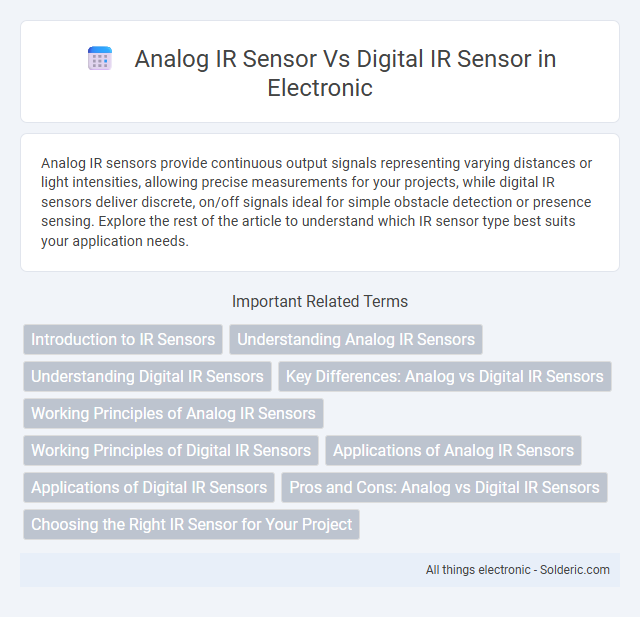Analog IR sensors provide continuous output signals representing varying distances or light intensities, allowing precise measurements for your projects, while digital IR sensors deliver discrete, on/off signals ideal for simple obstacle detection or presence sensing. Explore the rest of the article to understand which IR sensor type best suits your application needs.
Comparison Table
| Feature | Analog IR Sensor | Digital IR Sensor |
|---|---|---|
| Output | Continuous analog voltage proportional to IR intensity | Discrete digital signal (high/low) |
| Signal Processing | Requires ADC conversion for microcontroller interpretation | Direct interface with digital inputs, no ADC needed |
| Sensitivity | Variable sensitivity with fine gradient detection | Fixed threshold sensitivity |
| Complexity | More complex signal handling | Simple interface, easier integration |
| Cost | Generally lower cost | Typically higher cost |
| Applications | Distance measurement, proportional sensing | Obstacle detection, simple presence sensing |
| Accuracy | Higher accuracy with analog output | Lower resolution due to binary output |
| Power Consumption | Moderate | Lower, due to simpler circuitry |
Introduction to IR Sensors
Infrared (IR) sensors detect IR radiation to measure heat or motion, with analog IR sensors providing continuous voltage output proportional to the IR intensity, while digital IR sensors produce discrete signals indicating the presence or absence of IR radiation. Analog IR sensors are suitable for applications requiring precise measurements of IR levels, such as temperature sensing, whereas digital IR sensors are ideal for binary detection tasks like obstacle avoidance in robotics. The choice between analog and digital IR sensors depends on the required signal resolution and application needs.
Understanding Analog IR Sensors
Analog IR sensors provide continuous voltage output proportional to the infrared light intensity detected, allowing precise measurement of object distance or reflectivity. They use photodiodes or phototransistors to convert IR light into an analog signal, which requires an analog-to-digital converter (ADC) for microcontroller processing. These sensors excel in applications needing detailed gradient detection and fine sensitivity adjustments.
Understanding Digital IR Sensors
Digital IR sensors provide clear binary output signals indicating the presence or absence of an object, making them ideal for precise detection in automated systems. Unlike analog IR sensors, which measure varying voltage levels to represent distance or intensity, digital IR sensors simplify data processing by delivering straightforward on/off signals. Your choice of a digital IR sensor ensures reliable object detection and easier integration with microcontrollers or digital circuits.
Key Differences: Analog vs Digital IR Sensors
Analog IR sensors provide continuous output signals proportional to the intensity of infrared light detected, enabling precise measurement of distance or heat variations. Digital IR sensors deliver discrete output signals, often in binary form, indicating the presence or absence of an object or a specific threshold crossing. Key differences include signal type, with analog sensors offering variable voltage outputs for nuanced data, while digital sensors offer simplified, noise-resistant signals ideal for straightforward detection tasks.
Working Principles of Analog IR Sensors
Analog IR sensors operate by continuously measuring the intensity of infrared light reflected from an object, producing a variable voltage output proportional to the distance or presence of the object. These sensors rely on photodiodes or phototransistors to detect IR radiation, converting the received signal into a smooth analog voltage that varies with the amount of IR light detected. This analog signal enables precise distance measurement and fine-grained detection in applications such as obstacle avoidance, proximity sensing, and line tracking in robotics.
Working Principles of Digital IR Sensors
Digital IR sensors operate by detecting infrared light signals and converting them into binary output, indicating the presence or absence of an object. These sensors use photodiodes or phototransistors to sense IR radiation and employ internal signal processing circuits for precise threshold detection and noise filtering. The digital output simplifies integration with microcontrollers and digital systems, enabling accurate object detection and distance measurement in automation and robotics applications.
Applications of Analog IR Sensors
Analog IR sensors are widely used in applications requiring precise distance measurement and obstacle detection, such as robotics, automation systems, and proximity sensing. Their continuous output voltage proportional to the infrared light intensity enables accurate detection of varying distances and surface reflectivity. Industrial automation and consumer electronics benefit from analog IR sensors for tasks like line following, object avoidance, and environmental monitoring.
Applications of Digital IR Sensors
Digital IR sensors find extensive applications in obstacle detection, proximity sensing, and object counting due to their precise binary output that simplifies integration with microcontrollers. These sensors are widely used in consumer electronics, robotics, and industrial automation for presence detection and distance measurement within smart devices. Your projects benefit from the digital IR sensor's straightforward signal processing, enabling reliable real-time responses and improved system accuracy.
Pros and Cons: Analog vs Digital IR Sensors
Analog IR sensors provide continuous, variable output reflecting the intensity of infrared light, allowing precise measurements for distance or heat detection but may suffer from noise and require calibration. Digital IR sensors offer simple binary output indicating the presence or absence of an object, making them ideal for straightforward detection and easy integration with microcontrollers, though they lack detailed information about signal strength or distance. Your choice depends on whether you need nuanced analog data for advanced applications or simple digital signals for basic object detection.
Choosing the Right IR Sensor for Your Project
Analog IR sensors provide continuous voltage output proportional to the detected infrared light intensity, enabling precise distance measurement and fine-grained signal analysis. Digital IR sensors offer simple binary signals, indicating the presence or absence of an object, which simplifies integration for applications needing straightforward detection. Choosing the right IR sensor for your project depends on whether you require detailed distance feedback with analog sensors or easy, reliable object detection using digital sensors.
Analog IR sensor vs digital IR sensor Infographic

 solderic.com
solderic.com